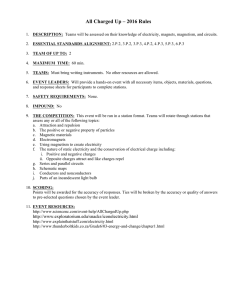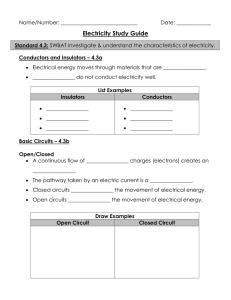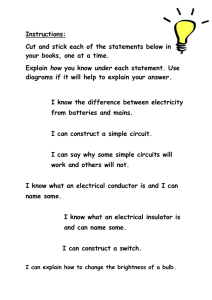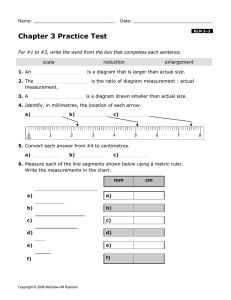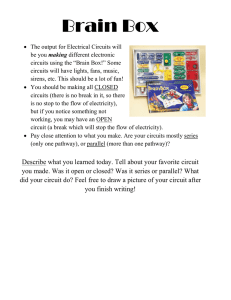Unit 4 Test - Holy Cross Collegiate
advertisement
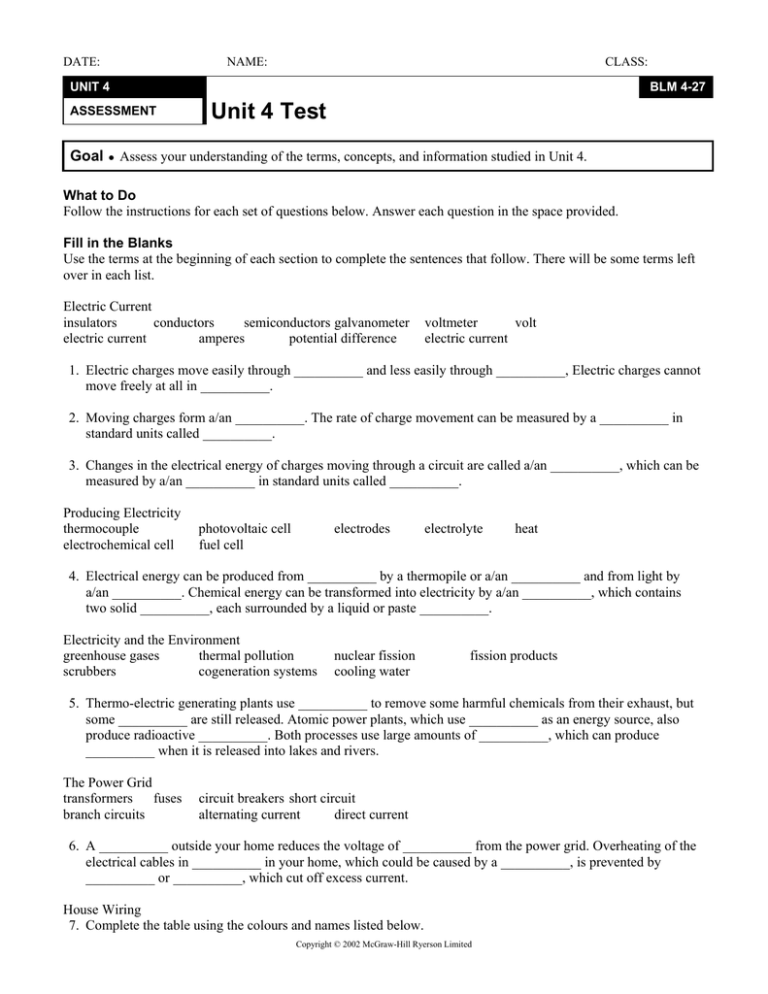
DATE: NAME: CLASS: UNIT 4 ASSESSMENT BLM 4-27 Unit 4 Test Goal • Assess your understanding of the terms, concepts, and information studied in Unit 4. What to Do Follow the instructions for each set of questions below. Answer each question in the space provided. Fill in the Blanks Use the terms at the beginning of each section to complete the sentences that follow. There will be some terms left over in each list. Electric Current insulators conductors semiconductors galvanometer electric current amperes potential difference voltmeter volt electric current 1. Electric charges move easily through __________ and less easily through __________, Electric charges cannot move freely at all in __________. 2. Moving charges form a/an __________. The rate of charge movement can be measured by a __________ in standard units called __________. 3. Changes in the electrical energy of charges moving through a circuit are called a/an __________, which can be measured by a/an __________ in standard units called __________. Producing Electricity thermocouple electrochemical cell photovoltaic cell fuel cell electrodes electrolyte heat 4. Electrical energy can be produced from __________ by a thermopile or a/an __________ and from light by a/an __________. Chemical energy can be transformed into electricity by a/an __________, which contains two solid __________, each surrounded by a liquid or paste __________. Electricity and the Environment greenhouse gases thermal pollution scrubbers cogeneration systems nuclear fission cooling water fission products 5. Thermo-electric generating plants use __________ to remove some harmful chemicals from their exhaust, but some __________ are still released. Atomic power plants, which use __________ as an energy source, also produce radioactive __________. Both processes use large amounts of __________, which can produce __________ when it is released into lakes and rivers. The Power Grid transformers fuses branch circuits circuit breakers short circuit alternating current direct current 6. A __________ outside your home reduces the voltage of __________ from the power grid. Overheating of the electrical cables in __________ in your home, which could be caused by a __________, is prevented by __________ or __________, which cut off excess current. House Wiring 7. Complete the table using the colours and names listed below. Copyright © 2002 McGraw-Hill Ryerson Limited DATE: NAME: CLASS: UNIT 4 BLM 4-27 ASSESSMENT colors: black names: branch Unit 4 Test (continued) green ground function supply high-energy electricity to appliances return low-energy electricity from appliances ground the case of appliances to prevent electric shock white hot yellow neutral wire color (a) wire name (b) (c) (d) (e) (f) Alternating and Direct Current 8. Classify each statement as applying to direct current (DC) or alternating current (AC). _____ (a) flows in one direction _____ (b) voltage is easily changed by a transformer _____ (c) used in the power grid _____ (d) produced by electrochemical cells and batteries _____ (e) generated by dynamos _____ (f) supplied to generators and motors through a split-ring commutator _____ (g) generated by the alternator in a car _____ (h) resembles the graph below Matching Match the contribution in column A with a name in column B. Write the letter of the correct response in the proper blank. There will be one name left over. _____ _____ _____ _____ _____ A 9. 10. 11. 12. 13. observed a compass deflection near a current-carrying wire discovered the basic principles of electromagnetism built the first electric battery discovered the principles of electrical resistance developed the idea of positive and negative electric charge Multiple Choice Circle the letter of the best answer to each question. 14. A negatively charged rod attracts (a) only positively charged objects (b) only negatively charged objects (c) neutral and positively-charged objects (d) neutral and negatively-charged objects Copyright © 2002 McGraw-Hill Ryerson Limited B (a) Einstein (b) Faraday (c) Franklin (d) Oersted (e) Ohm (f) Volta DATE: NAME: CLASS: UNIT 4 ASSESSMENT BLM 4-27 Unit 4 Test (continued) 15. If a balloon develops a positive electric charge, this means that it has (a) gained positive charges (b) lost positive charges (c) gained negative charges (d) lost negative charges 16. Which of the following devices is not used to prevent damage from electrostatic discharge? (a) a variable resistor (b) an ionizer (c) antistatic packaging (d) a grounding strap 17. Which statement best describes a good conductor of electricity? (a) low resistance; easy for charge to move (b) low resistance; difficult for charge to move (c) high resistance; easy for charge to move (d) high resistance; difficult for charge to move 18. Which statement best describes series and parallel circuits? (a) Series circuits have one current path but parallel circuits have several. (b) Series circuits have several current paths, but parallel circuits have only one. (c) Both series and parallel circuits have one current path. (d) Both series and parallel circuits have several current paths 19. Two light bulbs are connected in series and attached to a dry cell. One bulb is unscrewed from its socket. What happens to the brightness of the other bulb? (a) It remains the same. (b) It gets brighter. (c) It gets dimmer. (d) It does not glow. 20. According to Ohm’s Law, the relationship between current, voltage, and resistance in a circuit can be stated as (a) V = IR V (b) I = R V (c) R = I (d) All the above answers are correct. 21. In a series circuit the current is … (a) the same at every point (b) largest through the load (c) largest at the positive terminal of the battery (d) largest at the negative terminal of the battery Copyright © 2002 McGraw-Hill Ryerson Limited DATE: NAME: CLASS: UNIT 4 ASSESSMENT BLM 4-27 Unit 4 Test (continued) 22. Household appliances are connected in parallel so that they … (a) all use the same power (b) all carry the same current (c) all have the same resistance (d) can continue to work even if one fails or is disconnected 23. What is the difference between an electrochemical cell and a battery? (a) A battery is made up of several cells. (b) A cell is made up of several batteries. (c) A cell is rechargeable, but a battery is not. (d) A battery is rechargeable, but a cell is not. 24. Which combination of characteristics describes a wire that carries the most current without overheating? (a) large diameter, as long as possible (b) large diameter, as short as possible (c) small diameter, as long as possible (d) small diameter, as short as possible 25. Which of the following devices do not use electromagnets? (a) maglev trains (b) electric motors and generators (c) magnetic compasses (d) MRI medical imaging machines 26. A voltage is induced in a wire that is … (a) held still near a magnet (b) moved parallel to a magnet (c) moved at an angle to a magnet (d) wrapped tightly in a coil around a magnet 27. Which characteristic is typical of digital electronic devices? (a) have no electrical resistance (b) are based on electronic switches called transistors (c) require AC power (d) are seldom used in modern computers 28. If a halogen light bulb is 18% efficient, this means that most of the input electrical energy (a) is transformed into waste heat (b) is transformed into light (c) passes right through the bulb without being changed (d) is grounded to prevent electrical shocks Copyright © 2002 McGraw-Hill Ryerson Limited DATE: NAME: CLASS: UNIT 4 ASSESSMENT BLM 4-27 Unit 4 Test (continued) 29. Fuel cells make electricity by … (a) a chemical reaction that produces water (b) using sunlight to get charges moving (c) using two different metal strips in an electrolyte (d) using water pressure to move a turbine 30. Thermo-electric generating stations produce steam to turn generators by using energy released from … (a) sunlight (b) splitting atoms (c) ocean tides (d) burning fuels 31. What current flows in a 20 ohm electric toaster connected to a 120 volt source? (a) 0.166 A (b) 6.0 A (c) 100 A (d) 2400 A Extended Response Show appropriate diagrams, including labels, or problem-solving methods for each question below. 32. Draw a circuit diagram showing three cells in series connected to two lamps in parallel with each other. Included a switch that can shut down all current in the circuit. Show the direction of electron flow in each current path on your diagram. 33. Calculate the resistance of an electric kettle carrying a current of 9.5 A from a 120 V supply. Copyright © 2002 McGraw-Hill Ryerson Limited DATE: NAME: CLASS: UNIT 4 ASSESSMENT BLM 4-27 Unit 4 Test (continued) 34. A small electric hot plate transfers 45 kJ of thermal energy into a cup of water each minute. To do this, the hotplate requires 85 kJ of electrical energy. Calculate the efficiency of the hotplate. 35. During the winter, Amos leaves his 750 watt electric car heater running continuously for ten hours each night. If electrical energy costs 9.6 cents per kilowatt-hour, how much does it cost Amos to operate the heater during a 21-day cold snap? Copyright © 2002 McGraw-Hill Ryerson Limited
